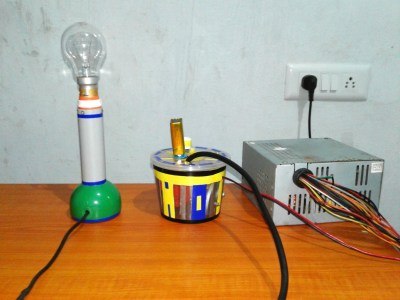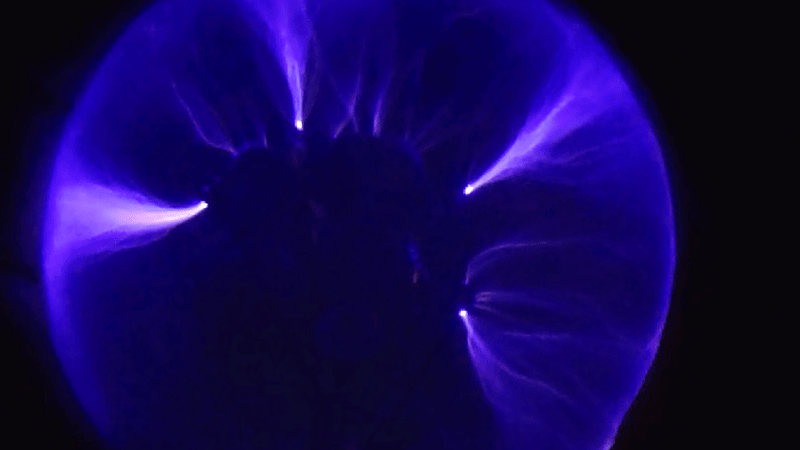The simple plasma ball – it graces science museums and classrooms all around the world. It shares a place with the Van de Graaf generator, with the convenient addition of spectacular plasma rays that grace its spherical surface. High voltage, aesthetically pleasing, mad science tropes – what would make a better DIY project?
For some background, plasma is the fourth state of matter, often created by heating a neutral gas or ionizing the gas in a strong electromagnetic field. The availability of free electrons allows plasma to conduct electricity and exhibit different properties from ordinary gases. It is also influenced by magnetic fields in this state and can often be found in electric arcs.

[Discrete Electronics Guy] built a plasma bulb using the casing from an old filament bulb and an ignition coil connected to a high voltage power supply. The power supply is based on the 555 timer IC. It uses a step-up transformer (the ignition coil) driven by a square wave oscillator circuit at a high frequency working as AC voltage. The square wave signal boosts the current into the power transistor, increasing its power.
The plasma is produced inside the bulb, which contains inactive noble gases. When touching the surface of the bulb, the electric arc flows to the point of contact. The glass medium protects the skin from burning, but the transparency allows the plasma to be seen. Pretty cool!




















“The availability of free electronics allows plasma to conduct electricity”
But what if I were to not get my plasma ball for free, doesn’t it work then?
Though, a fairly elegantly executed project non the less.
*grace it’s
*free electrons
*signal boosts
*medium protects
One per paragraph, I think that’s a new record!
Thanks. Fixed.
BTW: “its” not “it’s”.
One per comment!
*hard, I
*its
Those in glass houses should not throw stones.
Those who cannot write coherently should not nitpick other people’s grammar.
Muphry’s Law
“often created by heating a neutral gas or ionizing the has in a strong electromagnetic field.”
has?
gas?
1. Pick a project that was done by everyone who is into high voltage since at least 2001 and remake it.
2. Sell it as something innovative/great/worthy of HaD prize.
3. …
4. Profit!
I’ve seen CRT HV transformer based plasma balls, SSTC plasma balls and ignition coil plasma balls made since I had access to internet back in early 2001. Nihil novi sub sole…
Making something (even if already done before) is still infinitely more worthwhile than complaining about its lack of innovation in the comments … As a tangent did you know people have been complaining on the internet for decades? I’m disappointed by the lack of innovation your comment displays …
+1
Well said sjm4306. Perhaps Moryc, if you were more selective about the posts you bother reading you might find life less disappointing. That would be fairer to those brave and generous enough to post their projects.
lol, I was making these about 30+ years ago in about 1987. I tried out all sorts of bulbs including some big street lamp bulbs. power supply was the flyback from an old B&W TV and used a couple of big transistors to switch the power.
Even more fun was had when I discovered the voltage doublers used in colour TV’s :) making little balsawood models and ion thrusters.
Things kind of took a turn for the worsted when I managed to get my hands on an old 30Kv neon sign transformer. Did you know that when a florescent light strikes there is 0 resistance from one end to the other. I discovered this and being tagged with 30KV at 120ma is not fun.
Who cares if it was done decades ago, it’s still a fun project. Most everyone starts off in electronics, building projects from decades past. This is one of those, that never really gets old. I think it’s great to keep bringing these sorts of projects up occasional, maybe inspire some youngsters to build them, maybe catch an interest in electronics as a hobby or career. Most of the parts can be salvaged, or sourced cheap. It’s not always about building something new, or even useful, it’s the satisfaction of building, and it’s a bonus, if it actually works as expected.
Remember, kids! The only thing HaD readers want to see are totally novel concepts! Generally informative articles are unacceptable.
Care to show us your plasma ball?
>I’ve seen CRT HV transformer based plasma balls, SSTC plasma balls and ignition coil plasma balls made since I had access to internet back in early 2001.
You’ve seen, you’ve never done. Have you considered accomplishing something in your life instead of whining about those who do?
Our local old electronics mob released this as a $20 electronic kit in the 1993 era; 555, ignition coil. Shoved one together in 1994(?). Was cool for ten minutes. Always wanted to find a large light bulb to try it out. And with two component changes, it turned into an electric fence.
“The square wave signal boosts the current into the power transistor, increasing its power.”
The… what… I mean… guh? I recognize each of those words, but that sentence is bloody gibberish. It’s like Star Trek technobabble, but with less techno and more babble.
A really awkward way of saying they drive a flyback transformer with a squarewave on the primary through a transistor and the secondary generates a higher potential proportional to the windings’ ratio (albeit power isn’t increased … you know with conservation of energy and all). Let me give it a jumble and see if I can improve it: The current powers the square transistor into the signal power, increasing its wave … nope, makes about as much sense as the original lol.
“The square wave signal boosts the current into the power transistor, increasing its power.”
The square wave signal generated by the power transistor, is fed into the transformer, increasing the voltage”
Been there, done that.
The most interesting effect, yet kind of sad, was when I used a wire connected to the opposite electrode/part of the hv transformer and traced that wire (the bare metal part) once around the glass bulb (closed circle once around the circumference of the bulb).
Why? Because after a few seconds the glass split neatly into to two parts where I traced the glass with the wire.
It seems the heat of the arc that I traced around with the wire induced thermal stress, that caused the glass to neatly crack along my traced line. So I ended up with to glass parts. Interesting because you could open the bulb be splitting the glass into two parts instead of many glass shards.
Sadly you could only do that once and lost the (abbility to creat a) plasma within the bulb.
That’s interesting you had a bad run with the wire. Yours must have been more powerful than mine. I never had an issue with the wire around the globe.
I moved on to just ionizing the gas in the light globe by putting it in a microwave oven for a few seconds (4seconds was long enough )
Be careful, if not done right, a home brew plasma ball has the potential to emit xrays